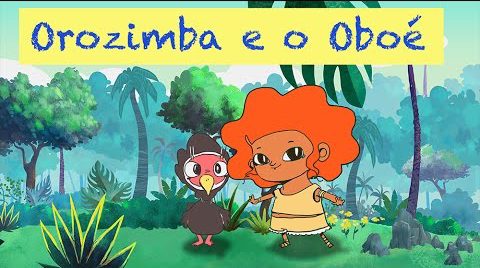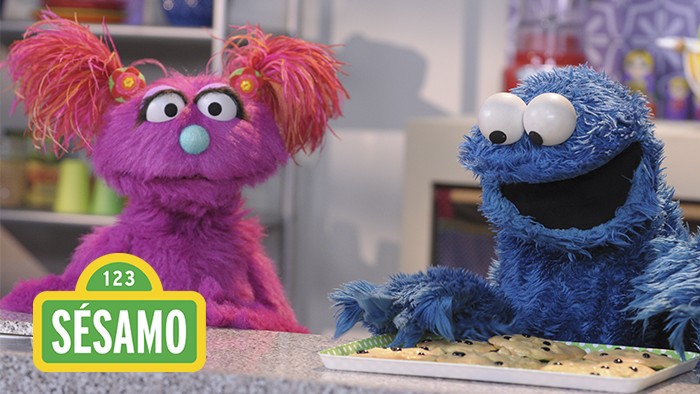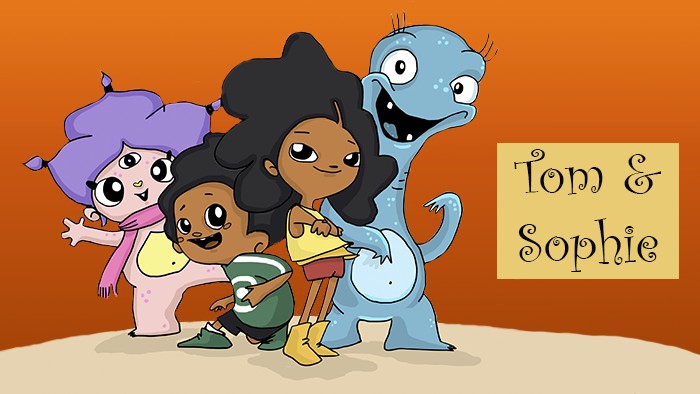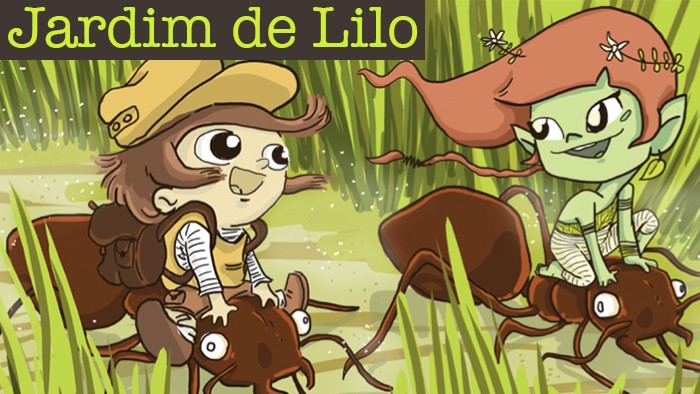
Jake & Isa and the Biomes of Brazil
Two children, Jake & Ísa, travel through 3 different biomes in Brazil, together with their father, the filmmaker João. Through the help they need to offer to an animal in danger, they uncover the importance and mysteries of each of these biomes. Divided into 3 chapters: The Wolf, The Termites and the Lobeira (about the Cerrado); The Jaguar and the Alligator? (about the Pantanal) and O Mico Leão Dourado (about the Atlantic Forest). The documentary will bring to our children, in a playful way, the importance of preserving Brazilian biomes.

Jake and Isa and the Secrets of Brazil
“Jake and Isa and the Secrets of Brazil” is a documentary series aimed at children aged 3 to 6. It features puppets as the main characters and seeks to spark children’s interest in Brazilian culture. The series showcases the country’s cultural diversity through the eyes of two children, Thiago and Ísis, who are 5 and 7 years old, respectively. In each episode, Thiago and Ísis set off with their father João (also a puppet) to discover a cultural tradition from different regions of Brazil and learn how these traditions are passed down from parents to children. The children take part in preparing the festivities, making decorations, and rehearsing dances and songs, offering them hands-on experience and insight into Brazil’s rich cultural diversity. Each episode culminates in a big celebration at the end.

Tropical Utopia

“Tropical Utopia” is a 70-minute-long documentary, mainly based on conversations between linguist and
political activist Noam Chomsky and diplomat and former Brazilian Minister of Foreign Affairs Celso Amorim. The documentary aims to take a critical look at the rise and fall of left-wing regimes in Latin
America during recent years. Through a view of these events, the film discusses the corruption and manipulation carried out by media in order to undermine the dream of a more just and pluralistic Latin America. A commentary from the point of view of two intellectuals that did not only follow these processes, but, in one way or another, exerted
some form of influence on them.

Survival Manual for the 21st Century
Recent extreme climatic events have struck around the world and also in Brazil, such as strong rains in the north of the country and the dramatic drought in the State of Sao Paulo that took water reserves down to critical levels. These events remind us of the increasingly fragile nature of our species when faced with the changes taking place on our planet.
All over the world, a new economic class is emerging and it has an insatiable hunger to consume, in a world where resources have become more and more scarce every day.
Looking at all the types of crises from the economic ones to the environmental ones and observing the wars fought over energy and natural resources, we must ask ourselves how we can survive as a species in the 21st century.
It is from within this scenario that the series “Survival Manual for the 21st Century” emerges. Presented by Marcos Palmeira, the series aims to illustrate how we might focus on reestablishing our post-collapsed society. Punctuated with dynamic animations and a bold soundtrack, the “Manual” shows how we can produce our own food, establish bartering systems and solidarity currencies, develop machines with open code technologies, construct a shelter using local materials, and create resilient and self-sustainable communities. Essentially, this series points out possible solutions for our Planet Earth, currently in a state of crisis. The series will air on the CineBrasil TV channel in the second semester of 2017.

Bela’s Roots
Bela Roots is a series of 13 episodes, each lasting 13 minutes. The series aims to offer alternative and holistic ways towards improved health. The natural food chef Bela Gil is the star of this series. During each episode, she will travel to a region of Brazil to meet shamans, medicine men, root doctors and other types of representatives from traditional communities, and visit the female leaders that keep these traditions alive. Bela will go to isolated quilombos and riparian and indigenous populations, among others, to discover how ancient customs, traditional medicine, food preparation and the choice of ingredients influence everyone’s health.

Orozimba
Orozimba and the Oboe is a fantastical story of a nine-year-old girl who, along with her pet vulture Mimi, lives out the adventure of saving a swamp and her father from the clutches of the evil scientist called Faustino. Along the way, Orozimba discovers her African and indigenous origins and finds out that she has magic powers: she possesses the power of music – when she plays the oboe (which belonged to her mother), she is able to communicate with the plants and animals around her, enchanting them into doing good deeds.
But the oboe disappears and she will do everything in her power to get it back. Clever and intelligent, she reveals the mysteries of nature and becomes a great defender of the forest. Throughout various adventures, she makes several friends and gets to know the universe and swamp creatures much better. She discovers that her father has been put under a spell and has ordered his factory to produce a rejuvenating miracle cream, which also has a destructive effect on the swamp. Produced by Amorim Filmes and directed by João Amorim.

Sesame
In 2017, Sesame Street returned to Brazil, now as Sesame. In a partnership with TV Culture and TB Brasil, Sesame Workshop produced two new seasons with 26 episodes each. Since 2014, Amorim Filmes has been overseeing all of Sesame’s content production here in Brazil. João Amorim signs off as the director and main producer of the two seasons. Included on this show reel version are several campaigns for Sesame that were produced by Amorim Filmes and directed/produced by João Amorim.

Elmo’s Challenge
Composed of 26 new animated episodes, the series “Elmo’s Challenge” brings together the beloved characters from the Sesame Street show as they live out typical daily situations. When they need to solve problems like, “Which healthy foods should we take on a picnic?”, “What things can we donate to a library?”, “What can we do to save electricity?” or “How can we plan how to become soccer players?” then Elmo and his friends find themselves on a fun “game show”, hosted by the clumsy Grover. Produced by Amorim Filmes and directed by João Amorim.

Tom and Sophie
 Tom and Sophie go into their room to play, where they imagine a fantasy world and transform many objects and furniture and where they become superheroes ready for action. The two siblings hold each other’s hands, close their eyes and say: “Imagine, imagine, so a new story can start to happen!” That’s when the monsters Loodo and Mona appear, fruits of their imagination; Mona jumps out of the closet and Loodo appears out from under the bed. Loodo and Mona, Tom and Sophie’s “alteregos”, represent their anxieties, fears and desires, and they give form to their fantasies. Loodo and Mona always come telling of problems from their monster world and they ask superheroes Tom and Sophie to help them solve problems and unmask mysteries that are similar to those the kids experience in the real world.
Tom and Sophie go into their room to play, where they imagine a fantasy world and transform many objects and furniture and where they become superheroes ready for action. The two siblings hold each other’s hands, close their eyes and say: “Imagine, imagine, so a new story can start to happen!” That’s when the monsters Loodo and Mona appear, fruits of their imagination; Mona jumps out of the closet and Loodo appears out from under the bed. Loodo and Mona, Tom and Sophie’s “alteregos”, represent their anxieties, fears and desires, and they give form to their fantasies. Loodo and Mona always come telling of problems from their monster world and they ask superheroes Tom and Sophie to help them solve problems and unmask mysteries that are similar to those the kids experience in the real world.
Once the adventure is over, after Tom and Sophie have helped their monster friends, the children’s mother opens the bedroom door and calls them; Monsters Loodo and Mona immediately return to their normal hiding places. Tom and Sophie answer their mother: “We’re coming, Mommy! We just finished our game!” From behind the clothes, Mona winks to the camera. Loodo grabs a hidden tennis shoe to chew on.

Lilo’s Garden
Lilo’s GardenO curioso e esperto Lilo coloca seu cinto de utilidades e seu chapeuzinho (uniforme de explorador da natureza) e vai brincar no jardim de casa. De repente, algo lhe desperta a curiosidade: uma fila de formigas carregando folhas; um casulo de lagarta; as formas das nuvens levadas pelo vento; o surgimento de um arco-íris; uma poça d’água com girinos.
Lilo segue o objeto de sua curiosidade: “Eu queria muito saber… Por que as formigas andam em fila?”, “Por que a lagarta faz um casulo?”; “Como as nuvens andam no céu?”; “Como surge um arco-íris?” Nesse momento, ouve um assobio e vê uma rajada de vento por entre as árvores: é Flora, a fada da Floresta, sua melhor amiga, em cima de sua folha voadora, sempre fazendo aterrissagens desastradas: “Não há mistério que Flora e Lilo não possam descobrir!”.
Flora faz uma mágica com sua varinha para que ela e Lilo possam ora encolher para entrar no mundo minúsculo dos insetos, ora voar até o ninho das aves ou ainda mergulhar na lagoa dos girinos. A natureza é sempre animada, os animais, as plantas, todos os seres convidam os personagens para viverem uma grande aventura. Quando Lilo e Flora retornam da viagem, dizem: “Uau! A natureza é mesmo mágica”!
 The curious and clever Lilo puts on his utility belt and his hat (an outdoor explorer uniform) and goes out to play in the garden. Suddenly, some scenes grab his attention: a line of ants carrying leaves; a caterpillar in a cocoon; the shapes of clouds blown in the wind; a rainbow that appears; a little pond with tadpoles in it.
The curious and clever Lilo puts on his utility belt and his hat (an outdoor explorer uniform) and goes out to play in the garden. Suddenly, some scenes grab his attention: a line of ants carrying leaves; a caterpillar in a cocoon; the shapes of clouds blown in the wind; a rainbow that appears; a little pond with tadpoles in it.
Lilo feeds his curiosity: “I really want to know… Why do ants walk in a line?”; “Why do caterpillars make cocoons?”; “Why do clouds float through the sky?”; “What makes rainbows appear?” Just then he hears a whistle and a strong wind blows through the trees: it’s Flora, his best friend, riding on top of her flying leaf and as usual, she makes a disastrous landing: “There’s no mystery that Flora and Lilo can’t unveil!”
Flora uses her magic wand to make her and Lilo able to either shrink to fit into tiny insect worlds or able to fly up to birds’ nest or even dive down into the tadpoles’ pond. Being in nature is always exciting and the animals, plants and all the forest creatures invite these characters to live out great adventures. When Lilo and Flora return from their trip, they say: “Wow! Nature really is magical!”

The Wolfy’s Gang
The Wolfy’s Gang and his five inseparable friends, the Nine-banded Armadillo, the Golden Lion Tamarin, the Jabiru Bird, the Blue Land Crab, and the Woodpecker, are trailblazers that travel can always be found with a world map in hand, headed towards the destination of their choice. A bit bumbling, they always seem to get lost and just when they think they’ll never reach their destination they start to notice the nature around them: the characteristics of the vegetation and climate. Then they realize they are finally where they wanted to get to. Relieved, they are then ready to enjoy their outing and find out all about that biome, but they end up coming across some animal or plant that needs their help.
The Maned Wolf and his gang get into big trouble in order to save their new friends: natural dangers like rushing water currents, heavy rain, predators, hunters and wildlife traders, among others. With courage and wisdom, they manage to solve each dilemma.











